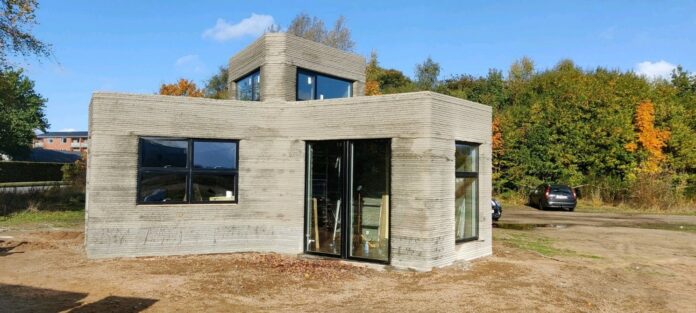The roof and the foundation were made by the construction 3D printer with low-cost real concrete
Have you ever thought about decluttering your life, selling most of your things, and moving into a tiny home? If so, you’re not alone. The movement that is by far the most famous in the USA, has been booming since 2010 in Europe as well.
Construction of a tiny house remains quite traditional, therefore it quite surprising to see that one company has explored the construction concept of these small houses using construction 3D printing. And it did it pretty well.
Danish 3D construction printing company, 3DCP Group 3D printed a 37 m2 tiny house located in Holstebro, Denmark. Described as the first of its kind in Europe, the tiny house is designed and fabricated to be as affordable as possible.
On just 37 m2 the building contains a bathroom, an open plan kitchen, a living room, and a bedroom. To save space, the bedroom was placed on a mezzanine floor above the bathroom. In line with Nordic building traditions wood is characterizing the interior, one learns.
The house is shaped in a triangular circle connected by an open middle core. In each end of the triangle, you find the kitchen, the living room, and the bathroom. To accommodate the bedroom on top of the bathroom, the roof above the end of the triangle with the bathroom and bedroom has been levitated.
Architect Sebastian Aristotelis from Saga Space Architects who designed the house says: “Our task was to make a small housing unit for students, which should contain all the rooms and functionalities of a normal house, but be so low cost, that even students could afford to live in it. We solved the task by making a design which provides a very effective use of each square meter still giving the inhabitants the feeling of being in a much larger house by having a large open area in the middle.”
From a manufacturing perspective, the team leveraged a COBOD’s BOD2 3D construction printer for the execution. To drive down cost the walls, roof and the foundation were 3D printed using low-cost real concrete (not mortar) – with an innovative new method for making the roof. Mikkel Brich, CEO of 3DCP Group found out that 3D printing uses 70% less concrete compared to concrete element construction and that CO2 emissions from construction sites can be reduced by up to 32% when using 3D printing. By automating processes and building with construction robots it is also possible to reduce the man-hours in the construction process by up to 50%.
The design of the house required the roof to be made of 5 parts, each with quite a unique shape. Sourcing such a roof from a precast plant would be virtually impossible and making it with formwork equipment was deemed to be very costly. Therefore, 3DCP Group used a new innovative method for making the roof, where the printer did as much of the roof as possible by letting it print the first part of the roof on the ground, after which the roof parts were lifted into place on the building and then casted together, the company explains.
“Making roofs with unusual shapes using our technology without the need for formwork equipment is a new and cost saving method for the construction sector globally”, Henrik Lund-Nielsen, Founder & General Manager of COBOD International comments.
Remember, you can post job opportunities in the AM Industry on 3D ADEPT Media free of charge or look for a job via our job board. Make sure to follow us on our social networks and subscribe to our weekly newsletter : Facebook, Twitter, LinkedIn & Instagram ! If you want to be featured in the next issue of our digital magazine or if you hear a story that needs to be heard, make sure you send it to contact@3dadept.com






